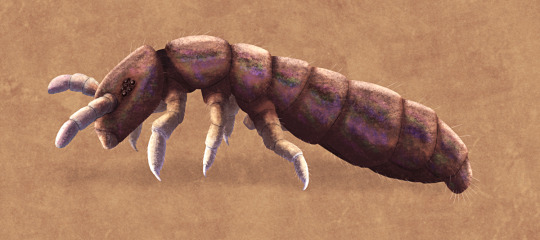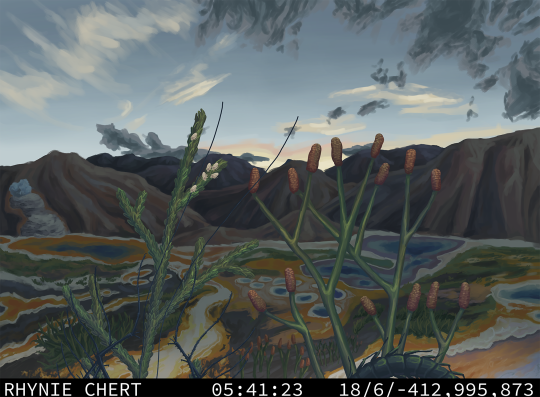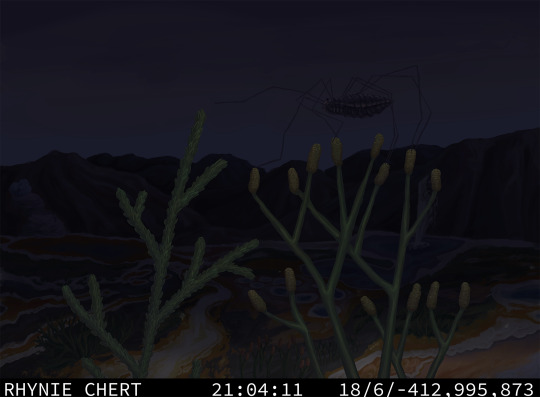#Rhynie
Explore tagged Tumblr posts
Text

#rockhound#geology#archaeology#paleontology#landscape#pareidolia#face#fossil#effigy#patalanagamanchilada#metamorphic#rocks#stone art#rhynie#chalcedony
3 notes
·
View notes
Text
SciTech Chronicles. . . . . . . . .Mar 28th, 2025
#Prototaxites#Devonian#Rhynie#chitin#cellulose#delignifying#lye#diethylenetriamine#ACC#hyperglycemic#hippocampus#anhedonia#ANNs#fMRI#autoencoder#RSA#dairy#high-value#reuse#upcycle
0 notes
Text
The Location of King Bridei’s Fort: New Clues from Adomnán’s Life of Columba?
By Fiona Campbell-Howes In my talk for NOSAS in October, I spent some time discussing the episodes in Adomnán’s Life of St Columba (hereafter the Life) in which the holy man visits the Inverness area, which Adomnán locates in provincia Pictorum, in the province of the Picts. For this blog I want to take a closer look at those episodes. In particular, I want to see if they contain any…

View On WordPress
#Adomnán#Alan Small and Barry Cottam#archaeology inverness#Bridei mac Maelchon#Broichan#Craig Phadrig#culduthel#Cullaird#E ware pottery#Elizabeth and Leslie Alcock#Glenurquhart#Inverness Castle hill#Inverness Field Club#Isabel Henderson#King&039;s Seat#Kingsmills#Knocknagael#Life of Columba#Luigne moccu Min#Mary Peteranna#Old Statistical Accounts of Scotland#pictish archaeology#Pictish bull carving#rhynie#River Ness#Rosemarkie Monastery#Scotland&039;s Early Silver#Steve Birch#Torvean Hillfort#Torvean silver chain
0 notes
Text

I was very much looking forward to this #paleostream! The tranquil of the Devonian Rhynie Chert fascinated me for a while. This geothermal wetland preserves some of the specimens of early landplants and is witness to the conquest of land by animals.

There was quite a bit of back and fourth in finding this composition. for once it turned out that the Prototaxites specimens from here are all quite small, also putting the camera down on the ground or underwater would have meant to loose sight of the colorful geothermal spring.


These geothermal springs are the reason for the exquisite preservation at Rhynie, regular flooding covered the local flora and fauna in silica, encasing in glass basically. This ensured that organisms were preserved down to cellular level and often time in situ.


Another challenge with this piece was how small the fauna from here is. Only a few creatures could be included here just by vertue of these early land arthropods being minuscule.
But I for once was more interested in the plants anyway.
268 notes
·
View notes
Text

Rhyniella praecursor was an early springtail that lived during the early Devonian, about 410-400 million years ago, in what is now Scotland. Discovered in the exceptionally well-preserved Rhynie chert fossil site, it's one of the earliest known hexapods.
It was around 2mm long (~0.08") and closely resembled some of its modern relatives – with distinctive anatomical features like a collophore and a furca – showing that springtails were already well-established in such an early terrestrial ecosystem.
It probably had a similar sort of ecological role to modern springtails, too, being involved in the breaking down of organic matter and the formation of soils.
———
NixIllustration.com | Tumblr | Patreon
References:
Dunlop, Jason A., and Russell J. Garwood. "Terrestrial invertebrates in the Rhynie chert ecosystem." Philosophical Transactions of the Royal Society B: Biological Sciences 373.1739 (2018): 20160493. https://doi.org/10.1098/rstb.2016.0493
"Collembolans." University of Aberdeen School of Geosciences, https://www.abdn.ac.uk/geosciences/departments/geology/research/the-rhynie-chert/the-learning-resource-site/fossil-fauna/collembolans/
Whalley, Paul, and Edmund A. Jarzembowski. "A new assessment of Rhyniella, the earliest known insect, from the Devonian of Rhynie, Scotland." Nature 291.5813 (1981): 317-317. https://doi.org/10.1038/291317a0
Wikipedia contributors. “Rhyniella” Wikipedia, 03 Dec. 2023, https://en.wikipedia.org/wiki/Rhyniella
#science illustration#paleontology#paleoart#palaeoblr#rhyniella#springtail#collembola#hexapod#arthropod#invertebrate#art#rhynie chert
126 notes
·
View notes
Text


OK time for more stones.
This six-foot gabbro boulder is incised with a curious figure known these days as the 'Rhynie Man'. It was turned up during ploughing near the village of that name in the 1970s; these days it's on display in the foyer of Woodhill House, the headquarters of Aberdeenshire Council. Literally just at the reception desk, so you can just nip in for a look, no appointments necessary or anything.
He's a bit of a mystery, really. His sharp teeth suggest to me that he's not meant to be a portrait of a local ruler, but it's hard to say what he is meant to represent. The stone doesn't have any symbols on it other than the Man himself, so it's difficult to date with any sort of precision, though the boulder being relatively unworked rather than shaped into a slab points towards it being one of the older ones, maybe 6th or 7th century. He could perhaps be some kind of local god or other hero; it's also been proposed that, if it's a later stone, he could have something to do with St Matthew, but I can't say I quite follow the reasoning behind that.
4 notes
·
View notes
Text
Yay, more love for trigonotarbids!
Trailcam: Rhynie Chert biota, fossil deposit known for it's very detailed fossils of plants and invertebrates due to them being petrified by volcanic hot springs, around 410 million years ago in the early Devonian.



[Image description: A series of digital illustrations of a geothermal landscape with blue and orange geothermal pools and clusters of green plants, with brown mountains in the background. In the front of the image, there are 2 plants close up. Image 1: At dawn, a Crussolum centipede, a dark blue centipede with long thin legs, reaches up to climb the plant on the left, which has some small Protacarus crani mites, appearing as small pale dots, climbing on the top. Part of a Leverhulmia mariae myriapod, looking like dark green millipede or centipede, is visible at the base of the second plant. Image 2: As a storm approaches in the day, an orange Palaeocharinus rhyniensis trigonotarbid, a small arachnid that looks like a spider with a flat, segmented abdomen and more small eyes, eats a small bluish white Lepidocaris rhyniensis crustacean, it caught from the edge of a drying up pool. Image 3: At night, Eophalangium sheari, a harvestman, is silhouetted against the sky as it climbs over the plants.]
#trigonotarbids#prehistoric arachnids#rhynie chert#palaeo trail cam#palaeo trail cams#palaeoart#palaeoblr
451 notes
·
View notes
Text
GEOLOGICAL FORMATION NAMES BE LIKE
LA BREA TAR PIT, GHOST RANCH, HELL CREEK, BONE CABIN, morrison, margaret, hilda, rhynie chert.
1 note
·
View note
Text
Fossil study sheds light on famous spirals found in nature
The findings indicate that the arrangement of leaves into distinctive spirals, that are common in nature today, were not common in the most ancient land plants that first populated the earth’s surface. Instead, the ancient plants were found to have another type of spiral. This negates a long held theory about the evolution of plant leaf spirals, indicating that they evolved down two separate evolutionary paths. Whether it is the vast swirl of a hurricane or the intricate spirals of the DNA double-helix, spirals are common in nature and most can be described by the famous mathematical series the Fibonacci sequence. Named after the Italian mathematician, Leonardo Fibonacci, this sequence forms the basis of many of nature’s most efficient and stunning patterns. Spirals are common in plants, with Fibonacci spirals making up over 90% of the spirals. Sunflower heads, pinecones, pineapples and succulent houseplants all include these distinctive spirals in their flower petals, leaves or seeds. Why Fibonacci spirals, also known as nature’s secret code, are so common in plants has perplexed scientists for centuries, but their evolutionary origin has been largely overlooked. Based on their widespread distribution it has long been assumed that Fibonacci spirals were an ancient feature that evolved in the earliest land plants and became highly conserved in plants. However, an international team led by the University of Edinburgh has overthrown this theory with the discovery of non-Fibonacci spirals in a 407-million-year old plant fossil. Using digital reconstruction techniques the researchers produced the first 3D models of leafy shoots in the fossil clubmoss Asteroxylon mackiei — a member of the earliest group of leafy plants. The exceptionally preserved fossil was found in the famous fossil site the Rhynie chert, a Scottish sedimentary deposit near the Aberdeenshire village of Rhynie. The site contains evidence of some of the planet’s earliest ecosystems — when land plants first evolved and gradually started to cover the earth’s rocky surface making it habitable. The findings revealed that leaves and reproductive structures in Asteroxylon mackiei, were most commonly arranged in non-Fibonacci spirals that are rare in plants today. This transforms scientists understanding of Fibonacci spirals in land plants. It indicates that non-Fibonacci spirals were common in ancient clubmosses and that the evolution of leaf spirals diverged into two separate paths. The leaves of ancient clubmosses had an entirely distinct evolutionary history to the other major groups of plants today such as ferns, conifers and flowering plants. The team created the 3D model of Asteroxylon mackiei, which has been extinct for over 400 million years, by working with digital artist Matt Humpage, using digital rendering and 3D printing. The research, published in the journal Science, was funded by UK Research and Innovation (UKRI), The Royal Society and the German Research Foundation. The study also involved researchers from, University College Cork, Ireland, University Münster, Germany and Northern Rogue Studios, UK. Dr Sandy Hetherington, an evolutionary palaeobiologist and the project’s lead at the University of Edinburgh, said: “Our model of Asteroxylon mackiei lets us examine leaf arrangement in 3D for the first time. The technology to 3D print a 407-million-year old plant fossils and hold it in your hand is really incredible. “Our findings give a new perspective on the evolution of Fibonacci spirals in plants.” Holly-Anne Turner, who worked on the project as an undergraduate student at the University of Edinburgh and is first author of the study, said: “The clubmoss Asteroxylon mackiei is one of the earliest examples of a plant with leaves in the fossil record. “Using these reconstructions we have been able to track individual spirals of leaves around the stems of these 407 million year old fossil plants. Our analysis of leaf arrangement in Asteroxylon shows that very early clubmosses developed non-Fibonacci spiral patterns.”
0 notes
Text
❤️ trigonotarbids

My 25 years of palaeoart chronology...
In 2013 I built 23 scale and life-size models for MUSE Science Museum, in Trento, Italy. Here's an enlarged Palaeocharinus, from the Devonian.
#Palaeocharinus#palaeoart#palaeoblr#paleoart#sculpting#awesome art#spider#not a spider#but tagging for arachnophobia#trigonotarbid#trigonotarbida#looks like this model is the image used when you search for this genus on Wikipedia#Rhynie chert#devonian
354 notes
·
View notes
Text
New research sheds light on origins of ancient Picts - Yahoo News UK
Aberdeen ^ | The Rhynie Man (Image: Aberdeen University). The origins of the Picts were local to the British Isles and not from large scale migration from ... http://dlvr.it/SnC8j3
0 notes
Text




1 note
·
View note
Text
CLAN CARRUTHERS-FABULOUS PICTISH HILLFORT REVEALED
CLAN CARRUTHERS-FABULOUS PICTISH HILLFORT REVEALED
CLAN CARRUTHERS INT SOCIETY CCIS PROMPTUS ET FIDELIS

FABULOUS PICTISH HILLFORT REVEALED
A spectacular hillfort overlooking a tiny Aberdeenshire village has been revealed as one of the largest ancient settlements ever discovered in Scotland.

University of Aberdeen archaeologists have uncovered evidence that up to 4,000 people may have lived in more than 800 huts perched…
View On WordPress
0 notes
Text
(dont worry id duplicated an autosave from 10 minutes before this and loaded that)
have removed climbing picks from available engrams and thrown out the ones i had, im never using those again
proceeded to farm so much metal with a rhyni and anky that my forge is slotcapped
CLIMBING PICKS CAN CONSISTENTLY DESTROY YOU AND YOUR ITEMS. DONT TRUST THEM.
7 notes
·
View notes
Text







Onwards to Rhynie. This village might ring a bell with you if you're up on your geology, because it's the find-spot of a deposit known as the Rhynie chert, famous for its extraordinarily preserved fossils of Devonian plants (and so, some of the earliest land plants in the fossil record).
This has nothing to do with the Rhynie chert, however. The first three stones here are displayed in a little shelter in the car park for the village cemetery. The first and smallest slab is carved with a Beast, though I appreciate this isn't especially clear, while the other two show a Crescent-and-V-Rod and a mirror, and a Double-Disc-and-Z-Rod, another mirror, and some kind of... depressed hand puppet creature?
Then in a field just south of the village stands the Craw Stane, still pretty much in situ but with the addition of a concrete base. I have not the faintest idea why they call it the Craw Stane, as the symbols carved on it are a fish (probably a salmon) above a Beast (a bit licheny, but still much clearer than the one in the car park), rather than anything resembling a crow.
3 notes
·
View notes
Photo

DSC_0582 farmhouse ruin, Woolshed Flat Road, 200m northwest of Milne Road, Rhynie, South Australia by JohnJennings995 https://flic.kr/p/2hVbcd3
0 notes